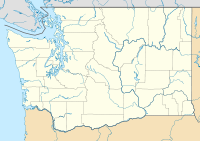- Mount Constance
-
Mount Constance Jefferson County, Washington, USA Elevation 7,756 ft (2,364 m) [1] Prominence 1,956 ft (596 m) [1] Location Range Olympic Mountains Coordinates 47°46′22″N 123°07′38″W / 47.772815078°N 123.1273536°WCoordinates: 47°46′22″N 123°07′38″W / 47.772815078°N 123.1273536°W[2] Topo map USGS Mount Deception Geology Type Basalt rock Age of rock Eocene Climbing First ascent 1922 by Robert Schellin and A.E. Smith Easiest route Rock & Ice climb Mount Constance is a peak in the Olympic Mountains of Washington and the third highest in the range. It is the most visually prominent peak on Seattle's western skyline. Despite being almost as tall as the ice-clad Mount Olympus to the west, Mount Constance has little in the way of glaciers and permanent snow due to warmer inland temperature and less precipitation.[3] In addition, the treeline here is higher than points to the west, also hinting at the warmer conditions here.
By virtue of its position at the eastern edge of the Olympics, Mount Constance also enjoys spectacular vertical relief. For example, it rises over 6,900 feet (2,100 m) above the Dosewallips River to the south in only 3 horizontal miles (5 km). It is also only 12 miles (20 km) from the tidewater of Hood Canal. The summit of Mount Constance lies on the boundary between Olympic National Park and Buckhorn Wilderness. The Constance massif includes Mount Constance, Inner Constance, the twin peaks of Warrior and Warrior's Arm.
Contents
History
In 1853, surveyor George Davidson named three mountains in the Olympics. He named Mount Ellinor for Ellinor Fauntleroy, who later became his wife, Mount Constance for Ellinor's older sister and The Brothers for her two brothers.[4]
Climbing
Routes on the mountain are from Class 3 to mid-Class 5, with ratings from Grade 2 to Grade 4.[5] Mount Constance was first climbed in 1922 by R. Schellin and A.E. Smith from the southeast.
Access
Boulder Ridge (including the Gargoyles, Charlia Lakes, Cloudy Peak, Alphabet Ridge, and Warrior) and Home Lake / Constance Pass are readily accessed via the Buckhorn Wilderness Area (U.S. Forest Service) side of the Upper Dungeness River Trail and Marmot Pass. An alternative approach to the Mt. Constance massif—including Inner Constance and the twin peaks of Warrior—is via the Dosewallips River Trailhead off of US 101 and Hood Canal. A third alternative is to access the Constance massif via Quilcene logging roads (FS 2700 aka "Penny Creek Road" off US 101) leading to a brief 6 - 7 mile ascent to Tunnel Creek Ridge and the high alpine shores of Harrison Lake. In fact, the most stunning views of the east side of Mt. Constance and Warrior are readily available from these roads (the lower portions of which are paved) which actually connect to FS 2800 and the Dungeness / Sequim area via the 5000-foot Bon Jon Pass.
References
- ^ a b "Mount Constance, Washington". Peakbagger.com. http://www.peakbagger.com/peak.aspx?pid=1022.
- ^ "Mt Constance". NGS data sheet. U.S. National Geodetic Survey. http://www.ngs.noaa.gov/cgi-bin/ds_mark.prl?PidBox=SY1607.
- ^ Google Earth images.
- ^ "The story of three Olympic peaks". Washington Historical Quarterly 4 (3): 182–86. https://digital.lib.washington.edu/ojs/index.php/WHQ/article/viewFile/5032/4109. Retrieved 2011-01-05.
- ^ Olympic Mountain Rescue (1988). Climber's Guide to the Olympic Mountains (3rd ed.). Seattle WA: The Mountaineers. p. 104.
External links
Categories:- Landforms of Jefferson County, Washington
- Mountains of Washington (state)
- Olympic Mountains
- Olympic National Park
Wikimedia Foundation. 2010.

